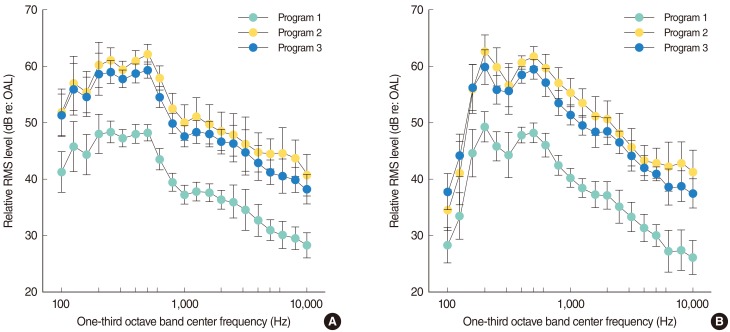Clin Exp Otorhinolaryngol.
2012 Jun;5(2):68-73. 10.3342/ceo.2012.5.2.68.
How Does Speaking Clearly Influence Acoustic Measures? A Speech Clarity Study Using Long-term Average Speech Spectra in Korean Language
- Affiliations
-
- 1Department of Otolaryngology-Head and Neck Surgery, St. Vincent's Hospital, The Catholic University of Korea School of Medicine, Suwon, Korea.
- 2Department of Otolaryngology-Head and Neck Surgery, Uijeongbu St. Mary's Hospital, The Catholic University of Korea School of Medicine, Uijeongbu, Korea. leedh0814@catholic.ac.kr
- KMID: 2117499
- DOI: http://doi.org/10.3342/ceo.2012.5.2.68
Abstract
OBJECTIVES
To investigate acoustic differences between conversational and clear speech of Korean and to evaluate the influence of the gender on the speech clarity using the long-term average speech spectrum (LTASS).
METHODS
Each subject's voice was recorded using a sound level meter connected to GoldWave program. Average long-term root mean square (RMS) of one-third octave bands speech spectrum was calculated from 100 to 10,000 Hz after normalizing to 70 dB overall level using the MATLAB program. Twenty ordinary Korean were compared with 20 Korean announcers with equal numbers of men and women in each group.
RESULTS
Compared with the LTASS of ordinary men, that of ordinary women was lower at low frequencies, but higher at 630, 800, 1,600, 5,000, and 10,000 Hz. Compared with the LTASS of male announcers, that of female announcers was lower at low frequencies. Compared with the LTASS of ordinary men, that of male announcers was significantly lower at 100, 125, 200, and 250 Hz. Compared with the LTASS of ordinary women, that of female announcers was lower at 100, 125, 160, 200, 250, 500, and 10,000 Hz. The LTASS of announcer showed lower levels at 100, 200 Hz and higher at 500, 630, 800, and 1,000 Hz that that of ordinary Koreans.
CONCLUSION
This study showed that the drop-off of the LTASS in the low frequency region might make the ratings of women and announcers more clearly than those of men and ordinary persons respectively. This drop-off in the low frequency might result in less upward spread of masking and clearer speech. This study reduced an error resulting from a wide variability of clear speech strategies and intelligibility gains, because this study recruited professional speakers. We hope that our results demonstrate the difference in acoustic characteristics of the speech of ordinary Korean persons.
Keyword
Figure
Reference
-
1. Picheny MA, Durlach NI, Braida LD. Speaking clearly for the hard of hearing I: intelligibility differences between clear and conversational speech. J Speech Hear Res. 1985; 3. 28(1):96–103. PMID: 3982003.2. Payton KL, Uchanski RM, Braida LD. Intelligibility of conversational and clear speech in noise and reverberation for listeners with normal and impaired hearing. J Acoust Soc Am. 1994; 3. 95(3):1581–1592. PMID: 8176061.
Article3. Tasko SM, Greilick K. Acoustic and articulatory features of diphthong production: a speech clarity study. J Speech Lang Hear Res. 2010; 2. 53(1):84–99. PMID: 19948757.
Article4. Smiljanic R, Bradlow AR. Speaking and hearing clearly: talker and listener factors in speaking style changes. Lang Linguist Compass. 2009; 1. 3(1):236–264. PMID: 20046964.5. Bradlow AR, Torretta GM, Pisoni DB. Intelligibility of normal speech. I: global and fine-grained acoustic-phonetic talker characteristics. Speech Commun. 1996; 12. 20(3):255–272. PMID: 21461127.
Article6. Kwon HB. Gender difference in speech intelligibility using speech intelligibility tests and acoustic analyses. J Adv Prosthodont. 2010; 9. 2(3):71–76. PMID: 21165272.
Article7. Cox RM, Moore JN. Composite speech spectrum for hearing and gain prescriptions. J Speech Hear Res. 1988; 3. 31(1):102–107. PMID: 3352247.8. Olsen WO, Hawkins DB, Van Tasell DJ. Representations of the long-term spectra of speech. Ear Hear. 1987; 10. 8(5 Suppl):100S–108S. PMID: 3678648.
Article9. Byrne D, Dillon H, Tran K, Arlinger S, Wilbraham K, Cox R, et al. An international comparison of long-term average speech spectra. J Acoust Soc Am. 1994; 10. 96(4):2108–2120.
Article10. Titze IR. Nonlinear source-filter coupling in phonation: theory. J Acoust Soc Am. 2008; 5. 123(5):2733–2749. PMID: 18529191.
Article11. Picheny MA, Durlach NI, Braida LD. Speaking clearly for the hard of hearing II: acoustic characteristics of clear and conversational speech. J Speech Hear Res. 1986; 12. 29(4):434–446. PMID: 3795886.12. Byrne D, Dillon H. The National Acoustic Laboratories' (NAL) new procedure for selecting the gain and frequency response of a hearing aid. Ear Hear. 1986; 8. 7(4):257–265. PMID: 3743918.
Article13. Cook JA, Bacon SP, Sammeth CA. Effect of low-frequency gain reduction on speech recognition and its relation to upward spread of masking. J Speech Lang Hear Res. 1997; 4. 40(2):410–422. PMID: 9130209.
Article14. Mefferd AS, Green JR. Articulatory-to-acoustic relations in response to speaking rate and loudness manipulations. J Speech Lang Hear Res. 2010; 10. 53(5):1206–1219. PMID: 20699341.
Article15. Liu H, Ng ML. Formant characteristics of vowels produced by Mandarin esophageal speakers. J Voice. 2009; 3. 23(2):255–260. PMID: 18082365.
Article16. Bradlow AR, Bent T. The clear speech effect for non-native listeners. J Acoust Soc Am. 2002; 7. 112(1):272–284. PMID: 12141353.
Article17. Ferguson SH. Talker differences in clear and conversational speech: vowel intelligibility for normal-hearing listeners. J Acoust Soc Am. 2004; 10. 116(4 Pt 1):2365–2373. PMID: 15532667.
- Full Text Links
- Actions
-
Cited
- CITED
-
- Close
- Share
- Similar articles
-
- Comparison of Speech Rate and Long-Term Average Speech Spectrum between Korean Clear Speech and Conversational Speech
- Gender difference in speech intelligibility using speech intelligibility tests and acoustic analyses
- Comparison of Speech-Language, Mental-Motor Development and Brain Radiologic Findings in Children with Cerebral Palsy and Other Delayed Development
- The Effect of Total Thyroidectomy on the Speech Production
- Current Status and Perspectives of Telepractice in Voice and Speech Therapy




